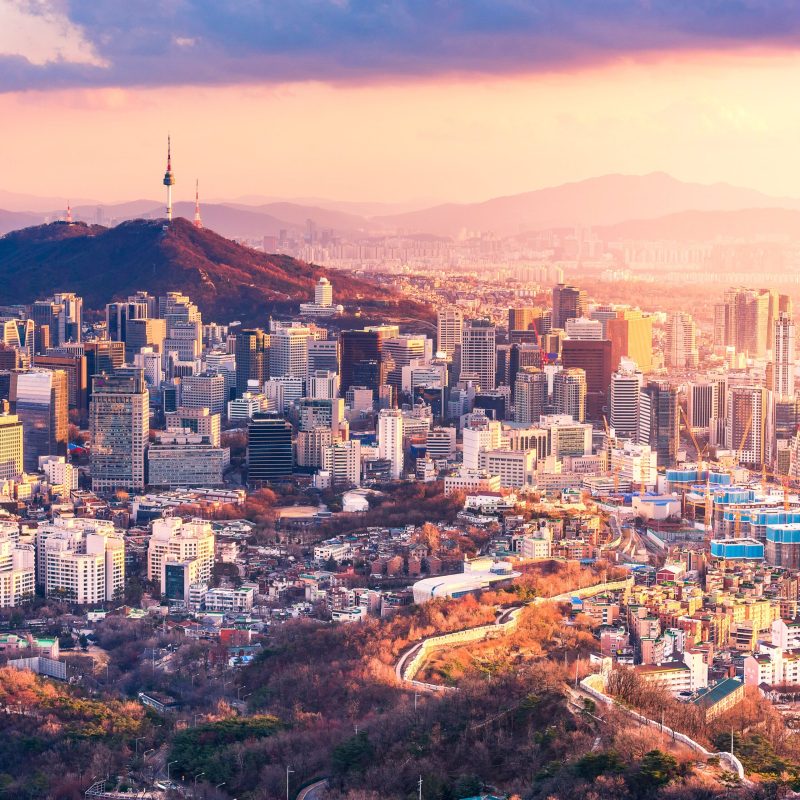
Seoul is a vibrant, enchanting city, and while vacationers often overlook it in favor of other East Asian cities like Tokyo and Beijing, that’s starting to change.
Videos by TravelAwaits
In 2016, 13.57 million foreign tourists visited Seoul, setting a new record for the city, and Seoul’s Tourism Promotion Foundation expects that number to continue to rise over the next decade.
For travelers, South Korea’s capital offers a virtually endless selection of once-in-a-lifetime experiences and amazing photo opportunities. If you’re planning a trip to Seoul — or if you’re daydreaming of a visit to a truly breathtaking city — here are a few of the most beautiful spots in Seoul to add to your itinerary.

1. Bukchon Hanok Village
If you can appreciate traditional architecture, you’ll fall in love with this little neighborhood, nestled near Jongmyo Shrine and Gyeongbokgung Palace (the latter of which has earned a spot on this list, too). Some of the buildings in Bukchon are hundreds of years old, and many were the residences of high-ranking government officials during the Joseon Dynasty, which ruled from 1392 to 1897.
In recent years, the Seoul Metropolitan Government has set strict visiting hours to prevent tourists from disrupting residents’ lives. As such, you’ll want to plan your visit between 9 a.m. and 5 p.m. Monday through Saturday. Also, be respectful; don’t take photographs of residents without their permission.

2. Jogyesa Korean Buddhist Temple
One of the most important temples in Korean Buddhism, Jogyesa was originally built in the late 14th century. After a fire, it was rebuilt as Gackhwangsa Temple in 1910, then renamed Tegosa Temple in 1936. In 1954, it was renamed Jogyesa Temple as part of a national effort to revive traditional Korean Buddhism.
Jogyesa is located in central Seoul on gorgeous grounds that sit serenely among the blocks of office buildings. It’s regularly used for worship, which, again, calls for a respectful approach. Visitors are allowed to enter the shrine and take pictures on the grounds. During the chrysanthemum festival (held annually from early October to early November), Jogyesa is filled with stunning flower displays.

3. Gyeongbokgung Palace
Gyeongbokgung is the largest of the Five Grand Palaces built during the Joseon dynasty. Japanese forces burned it to the ground toward the end of the 16th century, but it was rebuilt in 1867, and today, it’s one of the most popular tourist destinations in Seoul. It’s breathtaking, particularly for fans of Korean architecture.
Gyeongbokgung is closed on Tuesdays, but accessible most of the year (admissions are occasionally limited during special events, so be sure to visit the palace’s website when planning your trip). Visit the main gate to see the changing of the guard ceremony, which is held on the hour every hour from 10 a.m. to 3 p.m.

4. The DDP LED White Rose Garden
For a romantic night on the town, you can’t do much better than the Dongdaemun Design Plaza (DDP) rose garden. The 25,550 “flowers” are equipped with LEDs, so it’s not a traditional garden by any means — but that’s part of the appeal.
At nighttime, the garden lights up, providing a serene backdrop to the cityscape. The display was installed in 2015 to celebrate South Korea’s 70th year of independence. The garden is accessible year-round.

5. Ansan Starlight Village
Like the DDP rose garden, Ansan Starlight Village provides a year-round light display ideal for taking memorable photos. It’s organized into several areas with different themes that change throughout the year.
On a typical visit, you might walk past hundreds of meticulously decorated “animals” or venture down a path surrounded by umbrellas and hearts. It’s a slightly surreal experience, perfect for making memories.

6. Namsan Seoul Tower
Seoul’s skyline is nothing short of incredible, and there’s no better way to experience it than at Namsan Seoul Tower (commonly referred to as N Seoul Tower). Built in 1969, this transmission tower has a roof terrace, multiple restaurants, and numerous viewing platforms.
The terrace has a wooden viewing deck, perfect for relaxing and taking in the views. There’s also a Digital Observatory, which provides a 360-degree panoramic view of the city. Screens around the observatory provide visitors with information about the history of Seoul.

7. Cheong Wa Dae
The Korean presidential residence is also known as the Blue House (for obvious reasons). You’ll have to book an official tour to experience this attraction, but it’s worth the effort. An inscription on a stone wall reads: “The Most Blessed Place on Earth,” and the transcendent beauty of the Nokjiwon Garden, also on the property, lends itself to that claim.
In addition to the garden, you’ll get to walk through old building grounds, the Main Building, and the state guest house (Yeongbin-gwan) during your 60-minute tour. Book your visit to Cheong Wa Dae while scheduling your trip. Tours can be reserved as far as six months in advance (and must be scheduled at least 20 days ahead of time). Food and drinks are strictly prohibited, but the tours are free.
Fascinated by Asian architecture? Here’s how to see Vietnam’s beautiful Golden Bridge.

